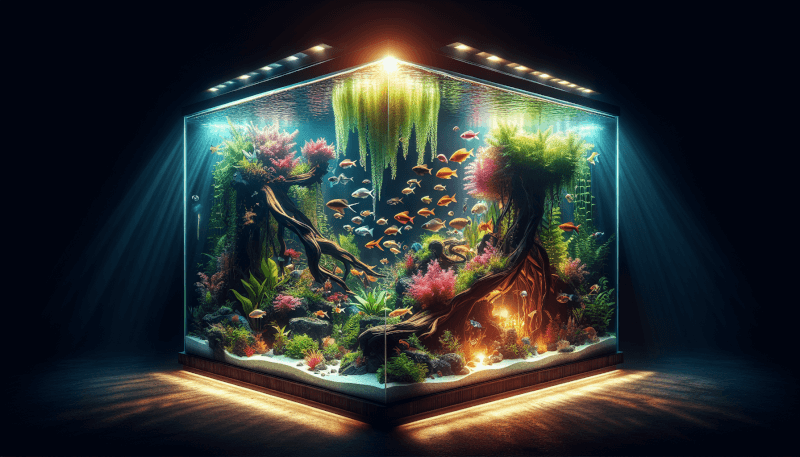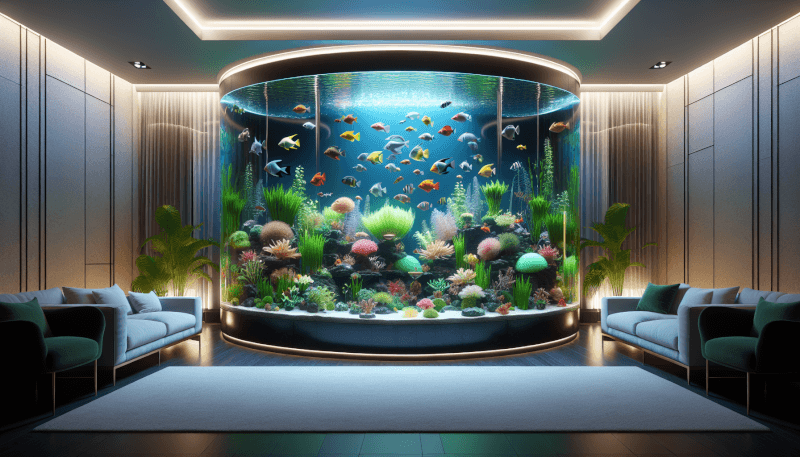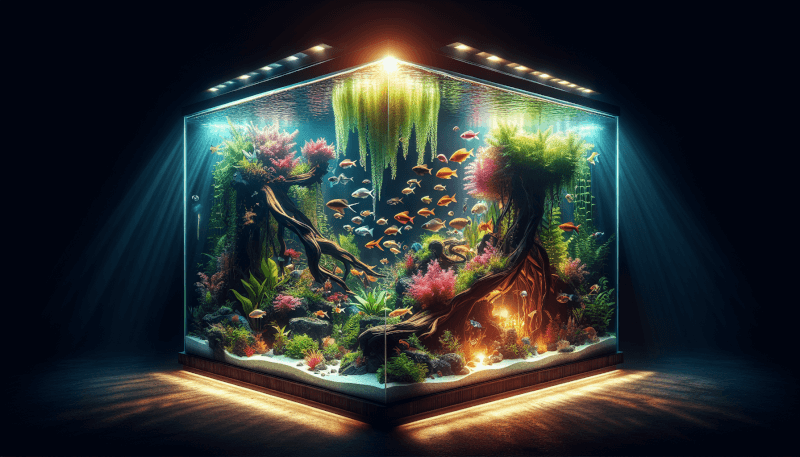Imagine yourself walking into a room where an aquarium sits in all its captivating glory. A sense of tranquility washes over you as you take in the beauty of the underwater world within that glass enclosure. But have you ever considered the impact that the size of an aquarium can have on the overall aesthetics and design? From the small and delicate to the grand and awe-inspiring, the size of an aquarium plays a crucial role in creating a visually appealing and harmonious space. In this article, we will explore how aquarium size can influence the aesthetic appeal and design of a space, and why choosing the right size can enhance the overall ambiance and allure that an aquarium brings. Get ready to embark on a journey through the captivating world of aquarium design.
The Importance of Aquarium Size
When it comes to creating a visually appealing and well-designed aquarium, size plays a crucial role. The size of your aquarium not only affects the aesthetics but also influences the design choices you can make. Whether you prefer a small, medium, or large aquarium, each size has its own advantages and considerations to keep in mind. In this article, we will explore the impact of aquarium size on aesthetics and design, as well as factors to consider when choosing the right size for your aquarium.
Factors to Consider When Choosing Aquarium Size
Before diving into the details of each aquarium size, it’s important to consider several factors that will ultimately determine the ideal size for your aquarium. These factors include the available space in your home or office, budget constraints, and the intended purpose of the aquarium.
Available Space
The first and most obvious factor to consider is the available space for your aquarium. You need to carefully measure the area where you plan to place the aquarium to ensure it fits comfortably without overcrowding the room. Keep in mind that larger aquariums require more space not only in terms of length and width but also in terms of height to accommodate fish and aquatic plants.
Budget Constraints
Another important consideration is your budget. The size of your aquarium will largely determine the costs associated with setting it up. Larger aquariums typically require more materials, such as glass or acrylic, and more equipment, such as filtration systems and lighting, all of which can add up quickly. Consider your budget and choose a size that meets your financial capabilities without compromising the overall aesthetics and functionality of the aquarium.
Intended Purpose of the Aquarium
Finally, consider the intended purpose of your aquarium. Are you looking to create a tranquil environment to relax and unwind? Or do you plan to have a vibrant and dynamic display of marine life? The purpose and intended use of the aquarium will help you determine the appropriate size. For example, if you want to showcase a variety of different fish species, a larger aquarium will allow for more diversity in terms of fish population and swimming space.

Small Aquariums: Aesthetics and Design
Small aquariums, typically ranging from 5 to 20 gallons, can be a great choice for beginners or those with limited space. Despite their small size, these aquariums offer several advantages and design possibilities.
Advantages of Small Aquariums
One of the main advantages of small aquariums is their affordability. They require less investment in terms of equipment, materials, and fish. Additionally, small aquariums are easier to maintain and clean compared to larger ones. They require less water changes and filtration, which make them more cost-effective in the long run.
Design Considerations for Small Aquariums
When designing a small aquarium, it’s important to consider the limited space available. Opt for smaller fish species that can thrive in smaller environments. Also, choose appropriate decorations and plants that don’t overcrowd the tank. Consider using vertical elements, such as tall rock formations or hanging plants, to create a sense of depth and maximize the visual impact of the limited space. Small aquariums are perfect for creating intimate and cozy displays, so make sure to choose a design that suits your personal preferences.
Medium-Sized Aquariums: Aesthetics and Design
Medium-sized aquariums, typically ranging from 30 to 75 gallons, offer more design possibilities and flexibility compared to small aquariums.
Benefits of Medium-Sized Aquariums
One of the main benefits of medium-sized aquariums is their versatility. These aquariums allow for a greater variety of fish species and decorations, without being too overwhelming in terms of maintenance and cost. They offer more swimming space for the fish, which promotes their overall health and well-being. Additionally, medium-sized aquariums create a more impactful visual presence in a room, becoming a focal point of the space.
Design Tips for Medium-Sized Aquariums
When designing a medium-sized aquarium, consider creating different aquatic zones within the tank. Use varied decorations, plants, and substrate to create distinct areas, such as a rocky or sandy bottom, which can provide a sense of depth and naturalness. Play with different colors to create visually appealing contrasts. Don’t forget to include hiding spots for the fish, such as caves or plants, to promote their sense of security and comfort. Medium-sized aquariums offer more freedom in terms of design choices, so let your creativity flow.

Large Aquariums: Aesthetics and Design
Large aquariums, typically ranging from 100 to 300 gallons or more, are the epitome of elegance and grandeur. These aquariums offer unparalleled visual impact and create a stunning focal point in any room.
The Impact of Large Aquariums on Aesthetics
Large aquariums have a significant impact on the aesthetics of a space. They create a sense of awe and wonder, captivating viewers with their sheer size and mesmerizing underwater world. Large aquariums are perfect for showcasing a diverse range of fish species, as well as creating intricate underwater landscapes. They provide ample space for fish to swim and explore, mimicking their natural habitats to a greater extent.
Design Strategies for Large Aquariums
When designing a large aquarium, consider incorporating different levels and dimensions to create a captivating display. Include a variety of decorations, rocks, and plants to simulate a natural underwater environment. Use larger fish species as the focal point and complement them with smaller schooling fish to create a balanced ecosystem. Lighting plays a crucial role in large aquarium design, as it can enhance the colors and patterns of the fish and aquatic plants. Consider using multiple light sources to create dynamic lighting effects throughout the aquarium.
Aquarium Shape and its Influence on Aesthetics
In addition to size, the shape of your aquarium also has a significant influence on aesthetics. There are several common shapes to consider when choosing an aquarium.
Rectangular Aquariums
Rectangular aquariums are the most popular and versatile choice. They provide a wide viewing area and offer plenty of swimming space for fish. Rectangular aquariums are also easier to maintain and clean due to their simple shape.
Circular and Curved Aquariums
Circular and curved aquariums offer a unique and visually pleasing alternative to rectangular tanks. They create a panoramic view and can be a great choice for smaller spaces or when a corner placement is desired. However, keep in mind that these tanks may have limited swimming space for fish, so choose the appropriate species accordingly.
Custom-shaped and Unconventional Aquariums
For those looking to make a bold statement, custom-shaped and unconventional aquariums can be a fantastic option. These aquariums come in a variety of shapes, such as hexagonal, pentagonal, or even freeform designs. They allow for more creative freedom and can be tailored to suit specific design preferences. However, it’s important to consider that custom-shaped aquariums may require custom-made equipment and may be more challenging to maintain.

Aquarium Placement: Enhancing Aesthetics through Strategic Positioning
The placement of your aquarium within a room can greatly enhance its aesthetics. Consider the following factors when choosing the perfect spot for your aquarium.
Natural Lighting and Reflections
Take advantage of natural lighting to enhance the visual appeal of your aquarium. Placing the aquarium near a window can create beautiful natural lighting effects, illuminating the fish and highlighting the colors of plants and decorations. However, be mindful of excessive sunlight, as it can lead to algae growth and temperature fluctuations.
Integration with the Surrounding Environment
Consider the overall design theme of the room and ensure that the aquarium complements its surroundings. Choose a placement that allows for seamless integration with the existing furniture and decor. A well-placed aquarium can become a seamless part of the room, adding a touch of elegance and tranquility.
Visibility and Accessibility
The visibility of the aquarium from different angles is also important. Ensure that the aquarium is easily visible from various vantage points within the room, allowing for maximum enjoyment. Additionally, consider the accessibility of the aquarium for maintenance purposes. Make sure there is enough space around the tank to perform regular cleaning and water changes without difficulty.
Aquarium Materials and their Impact on Aesthetics
The choice of aquarium material can greatly impact the overall aesthetics of your tank. The two main options are glass and acrylic aquariums.
Glass Aquariums
Glass aquariums are the most common choice due to their clarity and scratch resistance. They provide a crystal-clear view of the underwater world, allowing the colors and patterns of the fish and plants to shine through. Glass aquariums also have a sleek and elegant look that can seamlessly fit into any design style.
Acrylic Aquariums
Acrylic aquariums offer several advantages over glass. They are lightweight and more impact resistant, making them a safer option, especially in households with children or pets. Acrylic aquariums can also be shaped into unique and unconventional designs that are not possible with glass. However, it’s important to note that acrylic is more prone to scratches and requires special care to maintain its clarity.
Other Materials and Finishes
In addition to glass and acrylic, there are also other materials and finishes available for aquariums. Wood and metal frames, for example, can add a touch of elegance and sophistication to the overall design. Choose a material and finish that complements your desired aesthetic and suits the overall style of the room.

Aquarium Lighting: Illuminating the Aesthetics
Proper lighting is essential for enhancing the aesthetics of your aquarium. Consider the following aspects when choosing the right lighting for your tank.
Effects of Different Lighting Types
Different lighting types can create different effects and moods within the aquarium. Full spectrum lighting, such as LED lights, can simulate natural sunlight and bring out the true colors of the fish and plants. Colored lighting, on the other hand, can create a more dramatic and vibrant atmosphere, perfect for showcasing specific fish species or creating a specific theme.
Lighting Placement and Intensity
The placement of the lights within the aquarium is crucial for achieving the desired effect. Consider positioning the lights at different heights and angles to create depth and highlight specific areas of the tank. The intensity of the lighting should be balanced, ensuring that it’s not too bright or too dim, as it can affect the overall health of the fish and aquatic plants.
Using Lighting for Highlights and Shadows
Lighting can be used creatively to create highlights and shadows within the aquarium. By strategically placing the lights, you can accentuate specific decorations or rock formations, creating a more visually appealing and dynamic display. Experiment with different lighting angles and intensities to achieve the desired effect.
Maintenance and Aesthetics: Keeping the Aquarium Clean and Beautiful
Regular maintenance is crucial for keeping your aquarium clean and beautiful. Consider the following aspects to ensure the long-term aesthetics of your tank.
Regular Cleaning and Water Changes
Regular cleaning and water changes are essential for maintaining the overall cleanliness and clarity of the aquarium. Remove debris, vacuum the substrate, and clean the glass or acrylic surfaces to keep the tank looking its best. Perform regular water changes to maintain proper water quality and prevent the buildup of harmful substances.
Proper Filtration Systems
Invest in a high-quality filtration system that is appropriate for the size of your aquarium. A good filtration system will not only keep the water clean but also help in maintaining a healthy and balanced ecosystem. Clean and maintain the filtration system regularly to ensure optimal performance.
Algae Control and Management
Algae growth is a common issue in aquariums, especially if they receive excessive light or nutrient imbalances. Proper algae control and management are essential for maintaining the aesthetics of your tank. Regularly scrub the glass or acrylic surfaces to remove algae buildup, and ensure that the lighting and nutrient levels are properly balanced.
In conclusion, the size of your aquarium plays a significant role in its aesthetics and design. Whether you choose a small, medium, or large aquarium, each size offers its own advantages and considerations. Factors such as available space, budget constraints, and the intended purpose of the aquarium should be carefully considered when selecting the appropriate size. Furthermore, the shape, placement, materials, lighting, and maintenance of the aquarium also greatly impact its overall aesthetics. By considering these factors and following the design tips provided, you can create a visually stunning and aesthetically pleasing aquarium that will bring joy and tranquility to your home or office.



